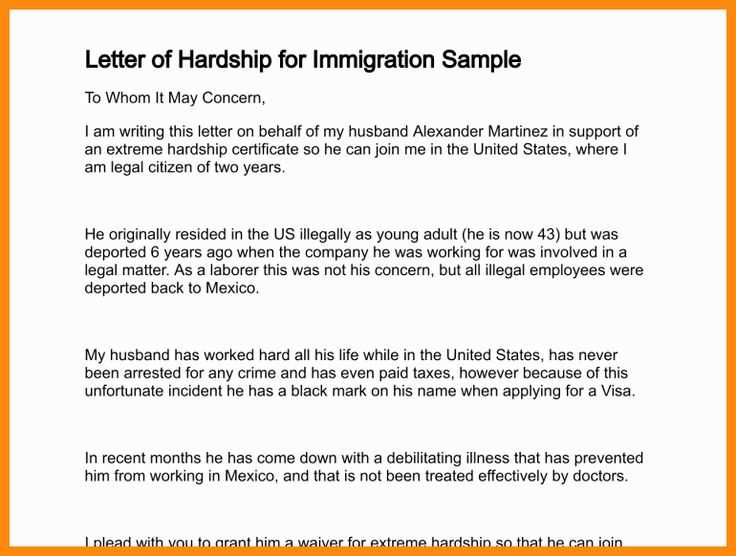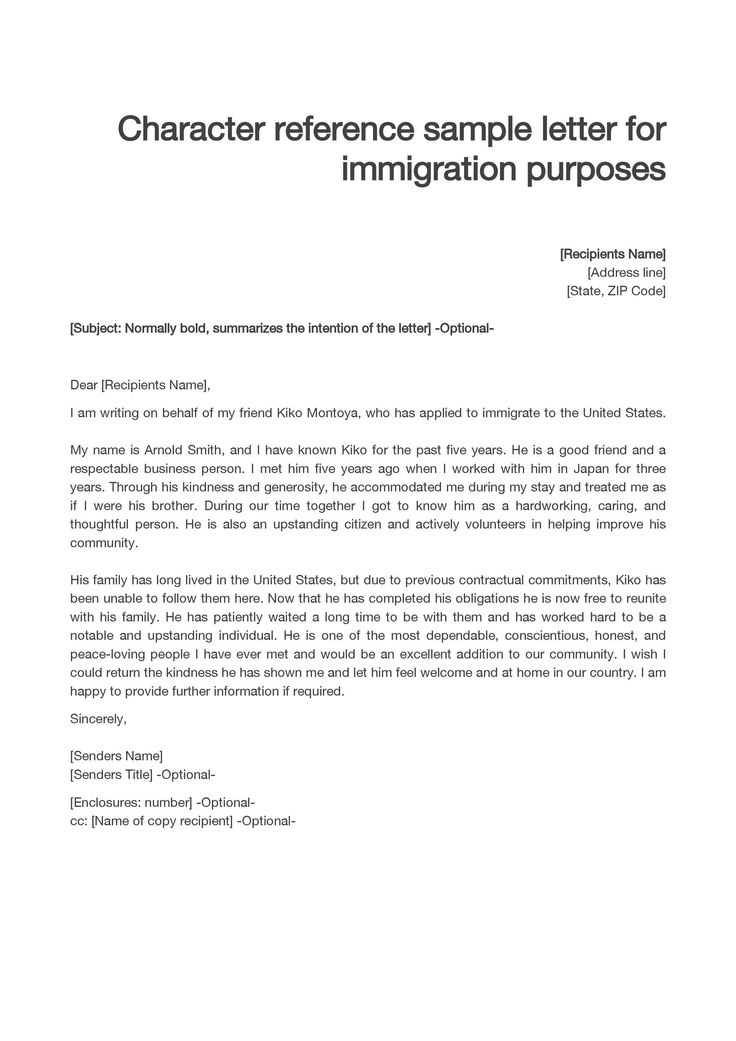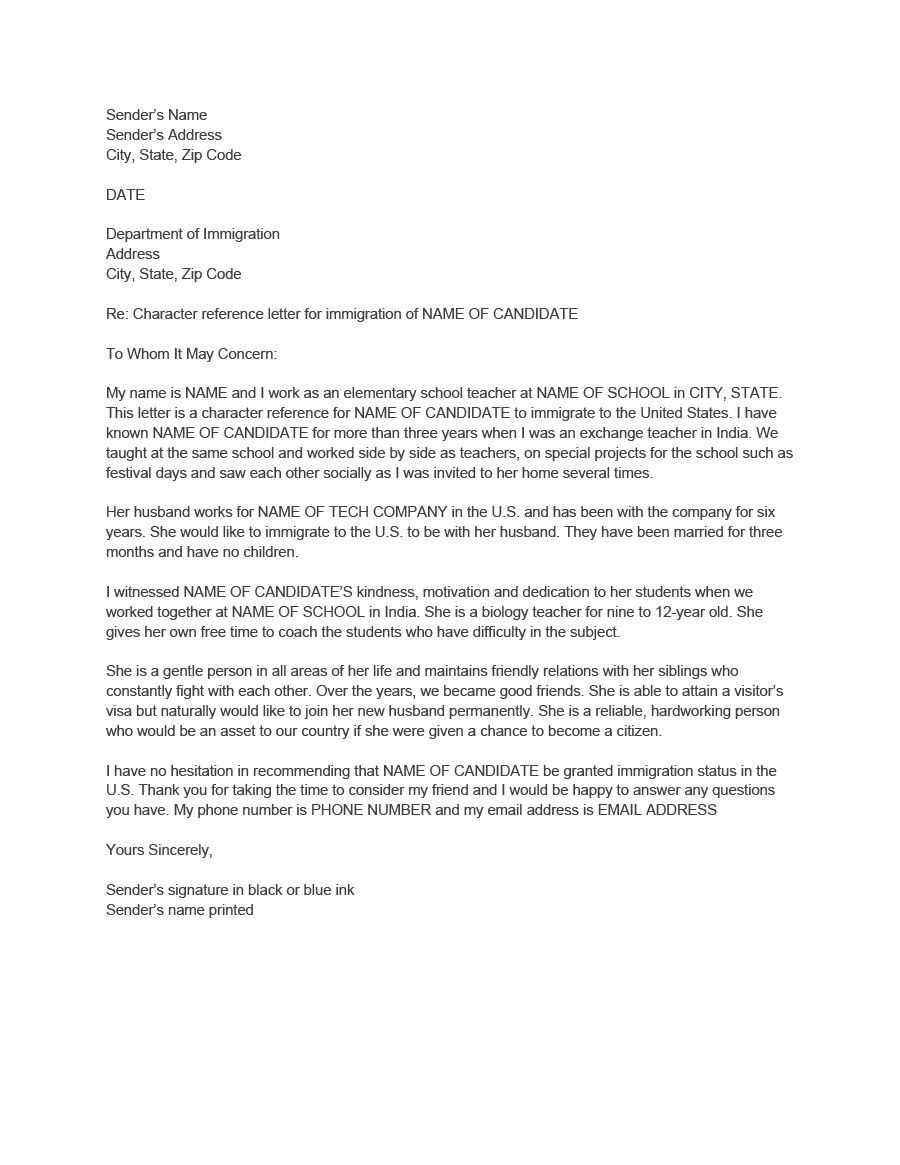Immigration Character Letter Template for Visa Applications

When applying for certain visa or residency programs, providing personal testimonies can play a crucial role. These documents help demonstrate an applicant’s reliability, trustworthiness, and positive impact on their community. Whether it’s for work, family reunification, or other purposes, such documents can offer an additional layer of support to the application process.
Crafting a compelling document that highlights an individual’s background and qualities can make a significant difference. The goal is to provide a detailed and honest account that strengthens the case in a clear and organized manner. The following sections will guide you through the essential steps of drafting this type of supportive material.
Knowing what to include and how to present the information effectively is key. This is not just about fulfilling a requirement, but also about offering a sincere portrayal that can influence decision-makers in the right direction.
Understanding Personal Support Documents
When applying for residency or visa opportunities, it is often necessary to provide documents that reflect an applicant’s background, reputation, and connections to the community. These documents are essential for authorities to assess whether the applicant meets certain social and moral criteria. They offer a deeper insight into the individual beyond just formal applications and help build a stronger case for approval.
Purpose of Support Documents

These documents are typically written by someone who knows the applicant personally and can speak to their values and conduct. The purpose is to verify the applicant’s good character and suitability for a new life or opportunity in the country. Here are some key reasons why these documents are important:
- They provide a personal perspective on the applicant’s integrity.
- They highlight the applicant’s positive contributions to their community.
- They help demonstrate reliability and trustworthiness to decision-makers.
What Makes a Strong Document
For the document to be effective, it must be honest, well-structured, and specific. A vague or overly general statement may not have the desired impact. A strong support document typically includes:
- A clear explanation of the relationship between the writer and the applicant.
- Examples of the applicant’s positive actions or personal qualities.
- A statement of the writer’s confidence in the applicant’s character and abilities.
Why Support Documents Are Important
Personal testimonials play a significant role in visa and residency applications by providing authorities with a fuller picture of an applicant’s background. These documents offer insight into an individual’s reputation, values, and contributions to their community, which are often not fully captured in official paperwork. A well-written document can be the deciding factor in determining the success of an application.
Support documents are valuable because they offer a personal endorsement from someone who knows the applicant well. They help build trust by showcasing the individual’s positive traits, such as integrity, reliability, and responsibility. These factors may not always be evident from official records, yet they are crucial in assessing whether an applicant is suitable for entry or residency.
In many cases, these documents serve as a powerful supplement to the more formal elements of an application. They provide context and depth, emphasizing the human side of the applicant, which can make a substantial difference in the decision-making process.
How to Write an Effective Support Document
When crafting a personal testimonial, it is important to present the information clearly and persuasively. A strong document not only outlines the applicant’s positive attributes but also provides concrete examples to back up the claims made. Writing an effective document requires attention to detail, honesty, and a clear structure that helps the reader easily understand the applicant’s qualities.
Start with a clear introduction that explains your relationship with the individual and how long you have known them. This establishes your credibility and sets the stage for your comments. It’s essential to be specific about the context in which you’ve observed the applicant’s actions and behavior, as this provides depth to your statement.
Provide specific examples that illustrate the applicant’s integrity, reliability, or other positive traits. These examples help paint a vivid picture and give weight to your claims. For instance, instead of simply stating that the person is trustworthy, you could mention a situation where they demonstrated responsibility or helped others in need.
Conclude with confidence by expressing your belief in the applicant’s character and their potential to succeed in their endeavors. A strong closing statement reinforces your support and leaves a positive impression.
Key Elements to Include in Your Document
To create an effective and impactful personal testimony, it’s crucial to incorporate several key elements that will strengthen the overall message. A well-structured document should convey both the applicant’s positive qualities and provide sufficient details to support these claims. By carefully considering what to include, you can ensure that the document makes a meaningful contribution to the application process.
Introduction and Relationship
Start by introducing yourself and explaining how you know the applicant. Mention the length of time you’ve known them and in what capacity. This gives context to your statement and establishes your authority as someone who can vouch for the individual’s behavior and reputation.
Concrete Examples and Specific Details
Examples are essential to demonstrating the applicant’s qualities. Simply stating that the individual is trustworthy or hardworking is not enough. Be specific about situations where the applicant showed these traits. For instance, you could describe how the person went out of their way to help others or consistently demonstrated responsibility in a challenging situation.
Honesty and Detail make all the difference. Including clear, factual examples will provide a more compelling case than vague or generalized statements. Avoid exaggeration, as sincerity is key to creating a document that resonates with decision-makers.
Common Mistakes to Avoid
When drafting a personal support document, it’s important to avoid common errors that can weaken the impact of your statement. These mistakes can result in a document that is unclear, ineffective, or fails to make a compelling case. By being aware of these pitfalls, you can ensure that your testimony is both persuasive and credible.
Overly General Statements

One of the most common mistakes is making vague statements without providing enough context or examples. Phrases like “This person is very kind” or “They are trustworthy” are not impactful on their own. Instead, provide specific instances where the individual demonstrated these qualities to give your claims more weight.
Lack of Structure

Another mistake is submitting a poorly organized document. A lack of clear structure makes it harder for the reader to follow your message and diminishes the overall effectiveness. A well-organized document should have an introduction, clear examples, and a conclusion that reinforces the main points.
| Common Mistake | Why to Avoid It | How to Fix It |
|---|---|---|
| Vague Statements | Fails to provide proof of claims | Provide specific examples and details |
| Lack of Structure | Hard to follow and unconvincing | Ensure clear sections with an introduction, body, and conclusion |
| Over-exaggeration | Reduces credibility and can seem insincere | Stick to factual, honest descriptions |
Tips for Strengthening Your Document
To make your personal endorsement more impactful, it’s important to focus on clarity, detail, and sincerity. Strengthening your message involves crafting a statement that resonates with decision-makers by being honest, precise, and well-supported with real examples. The following tips will guide you in creating a more compelling and persuasive document.
Be Specific with Examples
Concrete examples provide the foundation for a strong testimony. Instead of making broad claims, highlight specific actions or experiences that demonstrate the applicant’s positive traits. For example, rather than simply saying the individual is hardworking, describe a particular project or task where they went above and beyond expectations. The more tangible and relatable the example, the more convincing it will be.
Maintain a Professional Tone
Tone matters in creating an effective document. While it’s important to be personal and genuine, the overall tone should remain respectful and professional. Avoid overly casual language or anything that might come across as flippant. A balanced tone reflects well on both the applicant and the person writing the endorsement, helping the statement hold weight in the decision-making process.